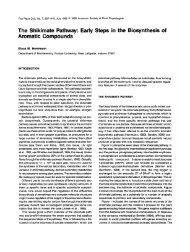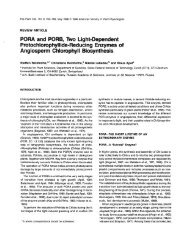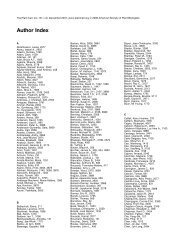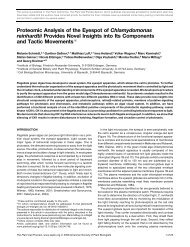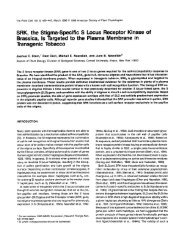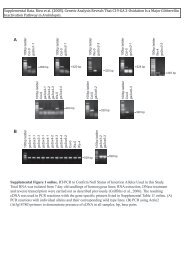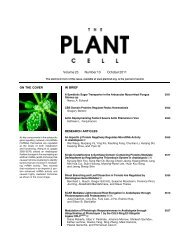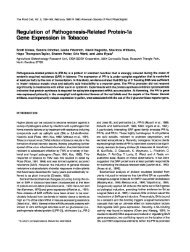The Angiosperm Gibberellin-GID1-DELLA Growth ... - The Plant Cell
The Angiosperm Gibberellin-GID1-DELLA Growth ... - The Plant Cell
The Angiosperm Gibberellin-GID1-DELLA Growth ... - The Plant Cell
You also want an ePaper? Increase the reach of your titles
YUMPU automatically turns print PDFs into web optimized ePapers that Google loves.
C-terminal region of the <strong>DELLA</strong> protein (McGinnis et al., 2003;<br />
Sasaki et al., 2003; Dill et al., 2004; Fu et al., 2004) and that<br />
targets <strong>DELLA</strong>s for destruction by the proteasome (Figure 3B).<br />
<strong>The</strong>se discoveries enabled a molecular understanding of how<br />
GA overcomes <strong>DELLA</strong> function and hence promotes growth: the<br />
growth-inhibiting <strong>DELLA</strong>s are targeted for destruction by the<br />
proteasome in response to GA following polyubiquitination by a<br />
specific E3 ubiquitin ligase of the SCF class (SCF SLY1/GID2 ), thus<br />
relieving <strong>DELLA</strong>-mediated growth inhibition. Nevertheless, the<br />
question of how GA promotes the <strong>DELLA</strong>- SCF SLY1/GID2 interaction<br />
remained, and it was only with the discovery of the GA<br />
receptor that it became clear how this occurs.<br />
THE GA RECEPTOR INTERACTS WITH DOMAINS I AND II<br />
OF THE <strong>DELLA</strong> PROTEIN<br />
<strong>The</strong> discovery of the GA receptor (Ueguchi-Tanaka et al., 2005)<br />
was a major advance in understanding of the GA-<strong>GID1</strong>-<strong>DELLA</strong><br />
mechanism. A rice gene (<strong>GID1</strong>) initially identified by loss-offunction<br />
gid1 alleles (conferring GA-insensitive dwarfism) was<br />
shown to encode a nuclear GA receptor protein (<strong>GID1</strong>; Ueguchi-<br />
Tanaka et al., 2005). <strong>GID1</strong> is localized (at least predominantly) in<br />
the nucleus and acts there as a soluble GA receptor, having high<br />
affinity for bioactive GAs and low or nonexistent affinity for<br />
inactive GAs. Remarkably, <strong>GID1</strong> binds specifically with the rice<br />
<strong>DELLA</strong> SLR1 when both proteins are expressed in yeast in the<br />
presence of bioactive GA. Unlike the case in Arabidopsis, whose<br />
genome encodes multiple <strong>DELLA</strong>s, SLR1 is the sole <strong>DELLA</strong><br />
protein encoded by the rice genome. Accordingly, lack of SLR1<br />
(in a slr1-1 loss-of-function mutant) suppresses the dwarfism<br />
conferred by a gid1 loss-of-function allele, and SLR1 accumulates<br />
in the gid1-1 loss-of-function mutant. Taken together, these<br />
observations suggested that GA potentiates an in planta interaction<br />
between the <strong>GID1</strong> GA receptor and <strong>DELLA</strong>s and that this<br />
interaction stimulates the GA-dependent destruction of <strong>DELLA</strong>s,<br />
thus promoting growth (Ueguchi-Tanaka et al., 2005).<br />
Genes encoding multiple <strong>GID1</strong>-related GA receptors were<br />
discovered in Arabidopsis, and mutants multiply homozygous for<br />
loss-of-function mutations in these genes were shown to exhibit<br />
GA-insensitive dwarfism (Griffiths et al., 2006; Iuchi et al., 2007;<br />
Willige et al., 2007). Further analysis showed that the <strong>GID1</strong>–<br />
<strong>DELLA</strong> interaction specifically involves the conserved N-terminal<br />
domains I and II of the <strong>DELLA</strong> protein (Peng et al., 1999a; Griffiths<br />
et al., 2006; Ueguchi-Tanaka et al., 2007; Willige et al., 2007;<br />
Feng et al., 2008), thus finally explaining why mutant <strong>DELLA</strong><br />
proteins lacking these domains confer GA insensitivity. In addition,<br />
the GA-stimulated interaction between <strong>GID1</strong> and <strong>DELLA</strong><br />
itself increases the affinity of <strong>DELLA</strong> for the SCF SLY1/GID2 E3<br />
ubiquitin ligase (Griffiths et al., 2006), presumably causing increased<br />
polyubiquitination of <strong>DELLA</strong>, subsequent destruction of<br />
<strong>DELLA</strong> by the proteasome, and the promotion of growth.<br />
Recent crystal structure studies have deepened our understanding<br />
of the molecular spatial relationships governing the<br />
interactions between <strong>GID1</strong>, GA, and <strong>DELLA</strong>. Essentially, the<br />
<strong>GID1</strong> protein possesses a central pocket that accommodates<br />
bioactive GA. Polar groups in the bioactive GA molecule interact<br />
directly with <strong>GID1</strong> and with water molecules via hydrogen bond-<br />
<strong>Growth</strong> Regulation by GA-<strong>GID1</strong>-<strong>DELLA</strong> 5 of 12<br />
ing, resulting in tight specificity of fit of bioactive GA within the<br />
pocket. For example, the C3-hydroxyl group (Figure 1A), which is<br />
essential for GA activity, is hydrogen bonded to a specific Tyr<br />
residue in the internal surface of the <strong>GID1</strong> pocket via a bridging<br />
water molecule (Murase et al., 2008; Shimada et al., 2008).<br />
Conversely, addition of a 2-hydroxyl group, an in planta mechanism<br />
for the inactivation of bioactive GAs in angiosperms<br />
(Yamaguchi, 2008), is predicted to cause steric interference<br />
and conformational changes that will not favor receptor binding<br />
(Murase et al., 2008).<br />
Binding of GA causes an allosteric change to <strong>GID1</strong>, which<br />
results in the N terminus forming a lid to the pocket (Murase et al.,<br />
2008; Shimada et al., 2008). Once in place, the upper surface<br />
of the lid binds with the <strong>DELLA</strong> protein, specifically with the<br />
N-terminal region defined by domains I and II (Murase et al.,<br />
2008). <strong>The</strong> formation of the GA-<strong>GID1</strong>-<strong>DELLA</strong> complex is thought<br />
to induce a conformational change in a C-terminal domain of the<br />
<strong>DELLA</strong> protein that stimulates substrate recognition by the<br />
SCF SLY1/GID2 E3 ubiquitin ligase, proteasomic destruction of<br />
<strong>DELLA</strong>, and the consequent promotion of growth.<br />
Intriguing recent evidence suggests that overcoming <strong>DELLA</strong>mediated<br />
growth inhibition does not equate solely with the<br />
destruction of <strong>DELLA</strong>. Experiments using mutant plants lacking<br />
the F-box component of the SCF SLY1/GID2 E3 ubiquitin ligase<br />
have indicated that the GA-dependent formation of the <strong>GID1</strong>-<br />
<strong>DELLA</strong> complex itself (independently of subsequent protein<br />
destruction) reduces the growth-repressing effects of the<br />
<strong>DELLA</strong>s (Ariizumi et al., 2008; Ueguchi-Tanaka et al., 2008).<br />
Given that <strong>DELLA</strong>s inhibit growth by interacting with specific<br />
growth-promoting transcription factors (see below), it is likely<br />
that formation of the <strong>GID1</strong>-<strong>DELLA</strong> complex reduces the availability<br />
of <strong>DELLA</strong>s for interaction with those transcription factors,<br />
thus reducing the resultant growth inhibitory effects. Thus, the<br />
GA-stimulated <strong>GID1</strong>–<strong>DELLA</strong> interaction inherently reduces<br />
<strong>DELLA</strong>-mediated growth repression as well as stimulating<br />
<strong>DELLA</strong> destruction.<br />
HOW <strong>DELLA</strong>s INHIBIT PLANT GROWTH<br />
<strong>The</strong> above advances define the molecular mechanism via which<br />
GA opposes the growth inhibitory properties of the <strong>DELLA</strong>s, but<br />
they do not explain how <strong>DELLA</strong>s inhibit growth. Because the<br />
C-terminal domain of <strong>DELLA</strong>s is closely related to that of SCR<br />
and other transcriptional regulators, it seemed possible that the<br />
<strong>DELLA</strong>s associate with DNA. However, there are no reports of<br />
direct <strong>DELLA</strong>–DNA associations. In addition, the moderate degree<br />
of promoter enrichment obtained in chromatin immunoprecipitation<br />
studies (Zentella et al., 2007) suggested that the<br />
association of RGA with gene promoters might involve additional<br />
transcriptional regulators.<br />
Further advances in understanding of how <strong>DELLA</strong>s inhibit<br />
growth have come from studies of plant light responses. <strong>Plant</strong><br />
growth is strongly influenced by the light environment. For<br />
example, the growth of the Arabidopsis seedling hypocotyl<br />
(expansion of the embryonic stem during seed germination and<br />
seedling establishment) is inhibited by light. A number of studies<br />
had previously implicated GA regulation as a component of




